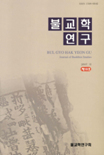- 영문명
- Reading “Tosolga” in Terms of Maitreya Buddhism
- 발행기관
- 불교학연구회
- 저자명
- 최정선(Choi Jungsun)
- 간행물 정보
- 『불교학연구』제19호, 151~182쪽, 전체 32쪽
- 주제분류
- 인문학 > 불교학
- 파일형태
- 발행일자
- 2008.04.30

국문 초록
영문 초록
Hyangga “Tosolga” and its related stories should be read in terms of Maitreya Buddhism to grasp its accurate meanings and functions. “Tosolga” was sung by Ven. Wolmyeong to eliminate the “two suns” in the sky which symbolize celestial disorder. “Two suns” have been explained as indicating conflicts between King and anti-King groups. However, it should be carefully re-examined in terms of political situation of King Kyeongdeok’s period, which was extremely unstable because of natural disasters and powers against the king. “Two suns in the sky” must be interpreted as referring to the king and his son. King Kyeongdeok was regarded as Maitreya Budda, reinforcing kingship on the base of the idea that the king is equal to Maitreya. His son, who was begot by divine will, was represented as an another sun. His son, later became the King Hyekong, was also regarded as a divine little boy, a descendant of Maitreya.
Meaningful and thoughtful solutions were suggested by Ven. Weolmyeong in his “Tosolga”. He had been a member of Kukseon, which was regarded as the society of the elites who embodied Maitreya. In the song, he prayed for consolidation of the king and the prince. The poetic words are straight, gentle and dignified, implying the right attitude toward Maitreya as a king. He also had noticed that the power of Hyangga came from native Korean language. In addition to all of these qualities, he managed to know the method of solving political problems in those days.
“Tosolga” and its circumstances were interweaved in a very delicate way. A rudimentary solution was exposed upon basis of Maitreya religion. As a result, the song carried the hope for fortification of kingly power and an optimistic way of resolving confliction.
Meaningful and thoughtful solutions were suggested by Ven. Weolmyeong in his “Tosolga”. He had been a member of Kukseon, which was regarded as the society of the elites who embodied Maitreya. In the song, he prayed for consolidation of the king and the prince. The poetic words are straight, gentle and dignified, implying the right attitude toward Maitreya as a king. He also had noticed that the power of Hyangga came from native Korean language. In addition to all of these qualities, he managed to know the method of solving political problems in those days.
“Tosolga” and its circumstances were interweaved in a very delicate way. A rudimentary solution was exposed upon basis of Maitreya religion. As a result, the song carried the hope for fortification of kingly power and an optimistic way of resolving confliction.
목차
Ⅰ. 들어가는 말
Ⅱ. 二日?現의 상징과 미륵신앙
Ⅲ. 미륵체상으로서의 〈도솔가〉
Ⅳ. 〈도솔가〉의 정치 이념과 불교적 기능
Ⅴ. 결론
Ⅱ. 二日?現의 상징과 미륵신앙
Ⅲ. 미륵체상으로서의 〈도솔가〉
Ⅳ. 〈도솔가〉의 정치 이념과 불교적 기능
Ⅴ. 결론
키워드
해당간행물 수록 논문
참고문헌
최근 이용한 논문
교보eBook 첫 방문을 환영 합니다!

신규가입 혜택 지급이 완료 되었습니다.
바로 사용 가능한 교보e캐시 1,000원 (유효기간 7일)
지금 바로 교보eBook의 다양한 콘텐츠를 이용해 보세요!


